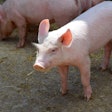
For the first time, African swine fever has been detected in Bataan province
In Asia, the devastating pig disease, African swine fever (ASF), has been reported for the first time in a new area of the Philippines. While outbreaks continue to be recorded in wild boar, South Korea’s pig population fell in the last three months of 2019 due to ASF. There have also been new cases in Russia’s Far Eastern region.
Bataan province is the latest area of the Philippines to be affected by ASF. The province is part of the Central Luzon region, where previous outbreaks have been confirmed.
ASF has been detected in four villages in the municipality of Dinalupihan, reports Sun Star. The town’s mayor said the villages are coordinating with the authorities to bring the disease situation under control.
According to Rappler, the ASF virus has also been detected in the Bataan town of Hermosa after some pigs there died.
New cases have also been confirmed in Central Luzon provinces of Tarlac and Pangasinan, reports the same source. As well as the infected animals, pigs in nearby herds are being culled to prevent the further spread of ASF.
There have been no recent official reports on the ASF situation in the Philippines.
ASF knocks South Korea’s pig population
According to the latest count, South Korean pig production dipped slightly in the last quarter of 2019. The figure of 11.28 million was reduced by the culling of around 400,000 pigs to prevent the spread of ASF, reports Yonhap.
Since mid-September 2019, there have been 14 ASF outbreaks on South Korean farms — nine in the province of Gyeonggi, and five in Incheon city. The most recent cases in domestic pigs were in October.
However, the virus continues to be detected in wild boar. Over the past week, South Korea’s agriculture ministry has reported to the World Organisation for Animal Health (OIE) a further 17 cases in this population.
Confirmed between December 27 last year and January 10, all these cases were found in Gyeonggi and Gangwon. These provinces border North Korea — where the disease was first reported months ago but where the current disease situation is unknown. Of the total, 14 of the cases were in Gyeonggi districts of Yeoncheon and Paju city. The Gangwon animals were in Cheorwan and, for the first time, in Hwacheon.
Since the first ASF outbreak in South Korea was reported in September 2019, the virus has been detected in 66 of the country’s wild boar, according to the United Nations’ Food and Agriculture Organization (FAO).
More ASF in Russian wild boar
Five more wild boar in Russia’s Far Eastern federal district have been found to be infected with ASF.
According to the official report from the agriculture ministry to the OIE, these animals were all found dead in the Jewish Autonomous Oblast (Yevreyskaya) this week.
ASF restrictions lifted in China
After previous ASF outbreaks, China’s agriculture ministry has lifted restrictions imposed in the Tengchong region of Yunnan province. No new cases have been detected in this area during the six weeks since the original outbreak.
Since the first cases in August 2018, China has culled 1.193 million pigs as the result of 165 ASF outbreaks in 32 regions, according to the FAO.
ASF situation in other regions
There have been no new reports of ASF outbreaks in Africa. In Europe, the disease appears to be spreading among domestic pigs in Bulgaria and Romania. Five countries have reported new cases in wild boar.
View our continuing coverage of the global African swine fever situation.

















